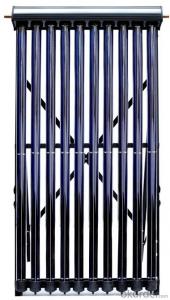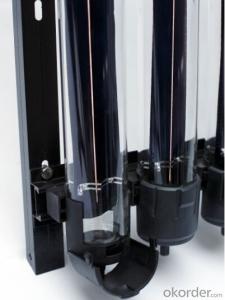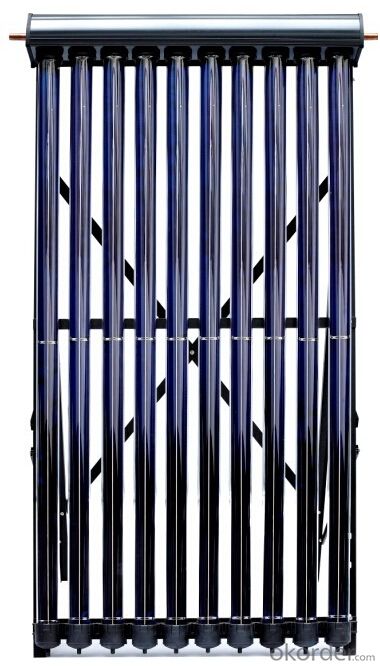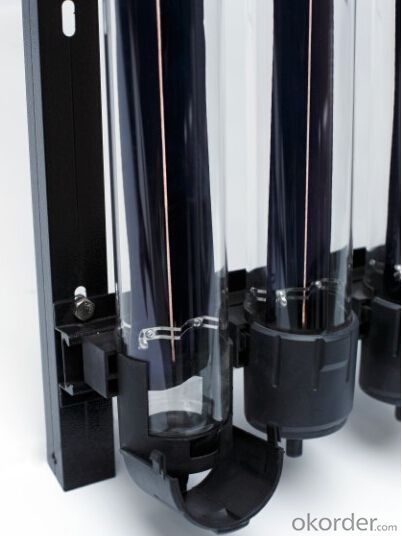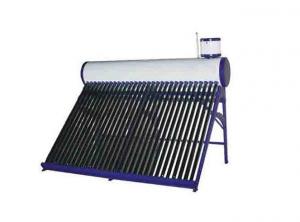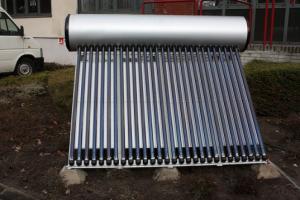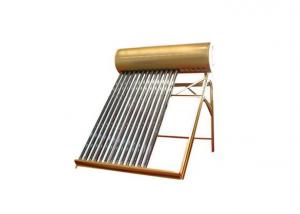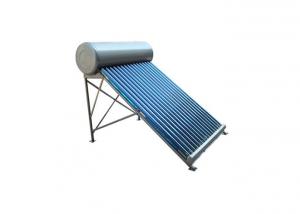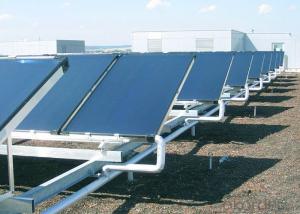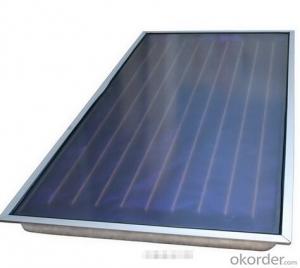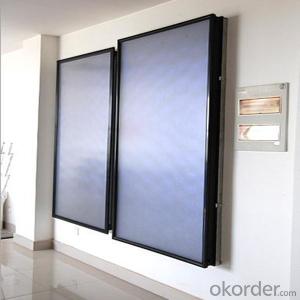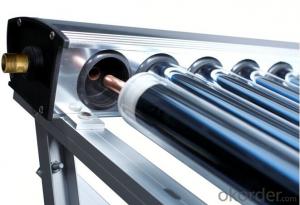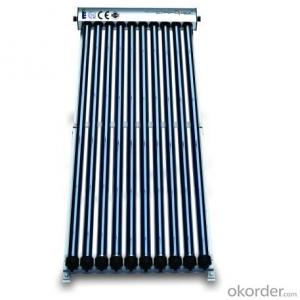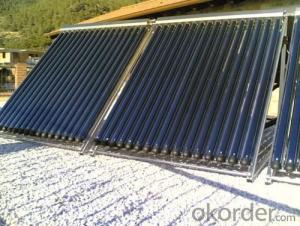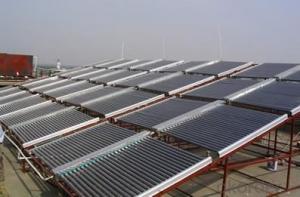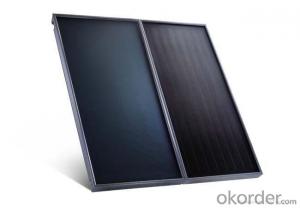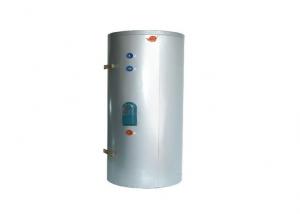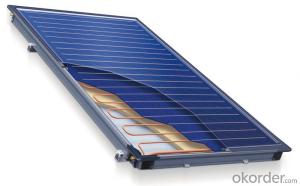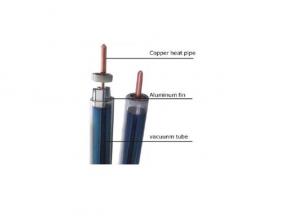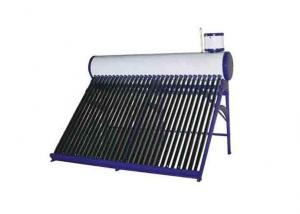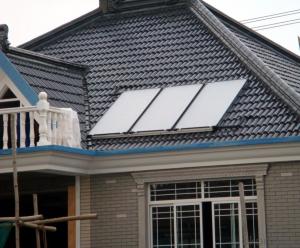Evacuated Tube Solar Collectors Metal Glass Heat Pipe Model SC-HM
- Loading Port:
- Shanghai
- Payment Terms:
- TT OR LC
- Min Order Qty:
- 20 set
- Supply Capability:
- 1500 set/month
OKorder Service Pledge
OKorder Financial Service
You Might Also Like
1. Structure of Metal Glass Heat Pipe for Solar Collector Model SC-HM
This Metal Glass Heat Pipe is an important part for solar collector, and the components are following as shown with graphic:
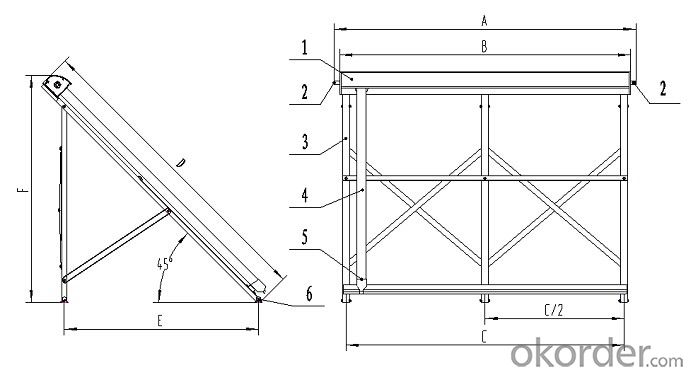
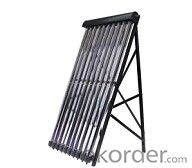
1 Manifold
2 Inlet & Outlet
3 Bracket
4 Metal Glass Vacuum Tube
5 Pipe Supporter
6 Anti-wind Foot
2. Main Features of Metal Glass Heat Pipe for Solar Collector Model SC-HM
The Metal glass vacuum tube is sealed together, high temperature, anti-freezing, insulation with vacuum.
Withφ70 vacuum tube, large collecting area, strong heat collecting efficiency, high temp, rapid heat conducting.
Aluminum alloy manifold & bracket weight less, the surface has treatment of oxidation. It can withstand corrosion resistance.
The super thick insulation layer is Molded rock wool/mineral wool, with high density & low coefficient of heat conductivity
The flow chute is made of high quality brass, with pressure and corrosion resistance, high purity and can withstand 1MPa pressure.
Adjustable pipe supporter and easy for installation.
3. Metal Glass Heat Pipe for Solar Collector Model SC-HM Images
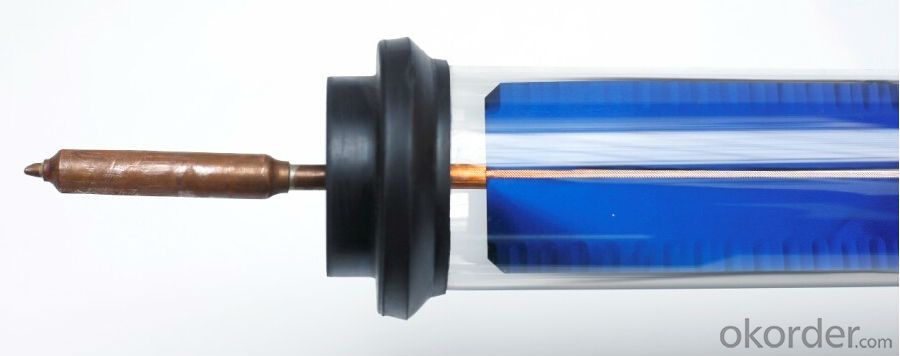
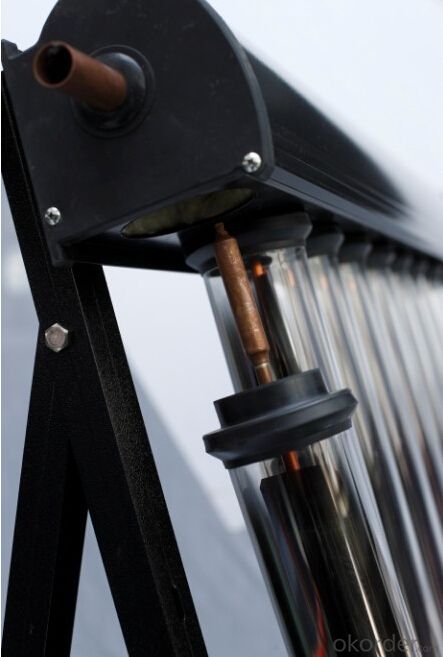
4. Metal Glass Heat Pipe for Solar Collector Model SC-HM Specifications
Model No. | SC-HM-10 | SC-HM-15 | SC-HM-18 | SC-HM-20 | SC-HM-24 | SC-HM-25 | SC-HM-30 |
No.of Vacuum Tube(PCS) | 10 | 15 | 18 | 20 | 24 | 25 | 30 |
Tube Space(㎜) | 100 | 100 | 100 | 100 | 100 | 100 | 100 |
OD/L of Vacuum Tube(㎜) | φ70/2000 | φ70/2000 | φ70/2000 | φ70/2000 | φ70/2000 | φ70/2000 | φ70/2000 |
Material of Vacuum Tube | Borosilicate glass 3.3 | Borosilicate glass 3.3 | Borosilicate glass 3.3 | Borosilicate glass 3.3 | Borosilicate glass 3.3 | Borosilicate glass 3.3 | Borosilicate glass 3.3 |
Material/Thickness of Heat Pipe(㎜) | Coppertp2/0.6 | Coppertp2/0.6 | Coppertp2/0.6 | Coppertp2/0.6 | Coppertp2/0.6 | Coppertp2/0.6 | Coppertp2/0.6 |
OD/Thickness of Flow Chute(㎜) | φ35/1.0 | φ35/1.0 | φ35/1.0 | φ35/1.0 | φ35/1.0 | φ35/1.0 | φ35/1.0 |
OD of Outlet & Inlet | φ22 or 3/4″ | φ22 or 3/4″ | φ22 or 3/4″ | φ22 or 3/4″ | φ22 or 3/4″ | φ22 or 3/4″ | φ22 or 3/4″ |
Insulation Material/Thickness(㎜) | Rockwool/40 | Rockwool/40 | Rockwool/40 | Rockwool/40 | Rockwool/40 | Rockwool/40 | Rockwool/40 |
Working Pressure(MPa) | 0.6 | 0.6 | 0.6 | 0.6 | 0.6 | 0.6 | 0.6 |
Working Temp ℃ | <150 | <150 | <150 | <150 | <150 | <150 | <150 |
Capacity of Solar Collector(L) | 0.69 | 0.98 | 1.15 | 1.27 | 1.50 | 1.56 | 1.85 |
Collecting Area(㎡) | 1.37 | 2.05 | 2.46 | 2.73 | 3.28 | 3.41 | 4.10 |
Total Area(㎡) | 2.20 | 3.28 | 3.92 | 4.35 | 5.21 | 5.43 | 6.50 |
Flow Rate(L/min) | 1.06 | 1.49 | 1.79 | 2.0 | 2.4 | 2.5 | 3.0 |
drop of pressure (Pa) | 16.24 | 41.4 | 63.4 | 81.7 | 127.2 | 140.1 | 219.8 |
Intercept efficiency η0 | 0.77 | 0.77 | 0.77 | 0.77 | 0.77 | 0.77 | 0.77 |
Heat loss rate a W/㎡℃ | 1.9 | 1.9 | 1.9 | 1.9 | 1.9 | 1.9 | 1.9 |
Efficiency(W)1000W/㎡irradiation | 744 | 1044 | 1256 | 1398 | 1681 | 1748 | 2098 |
N.W(kg) | 40.25 | 52.75 | 61.75 | 66.75 | 81.00 | 85.35 | 100.70 |
a (㎜) | 1115 | 1615 | 1915 | 2115 | 2515 | 2615 | 3115 |
b (㎜) | 1025 | 1525 | 1825 | 2025 | 2425 | 2525 | 3025 |
c (㎜) | 950 | 1450 | 1750 | 1950 | 2350 | 2450 | 2950 |
c/2 (㎜) | —— | —— | 875 | 975 | 1175 | 1225 | 1475 |
d (㎜) | 2150 | 2150 | 2150 | 2150 | 2150 | 2150 | 2150 |
e (㎜) | 1375 | 1240 | 1240 | 1240 | 1240 | 1240 | 1240 |
f (㎜) | 1590 | 1590 | 1590 | 1590 | 1590 | 1590 | 1590 |
5. FAQ
1. What happens if one of the solar tubes is broken?
Firstly, tubes are very strong and not easily broken, but if the worst should happen, solar tubes can be replaced very easily. They are inexpensive and available. The solar collectors can operate with several broken tubes, but the efficiency will be reduced, so it is recommended that broken tubes be replaced immediately.
2. Can the solar collectors be mounted on a flat surface?
Yes they may be mounted on a flat roof or on the ground by using a stainless steel Flat Roof Frame. The collector should be installed at a minimum of 20o angle to ensure optimal operation of the heat pipe.
3. Will the solar collector be a fire hazard during hot, dry weather?
No. The solar collector's components are all high temperature rated and non-flammable, so even during strong sunlight with the circulation pump turned off (stagnation), the system will not catch alight or give off any sparks. The majority of the solar collector's components are stainless steel, aluminium, glass or glass wool. The manifold outlet should be fitted with a temperature relief valve, which will prevent the manifold temperature from exceeding 99oC / 212oF.
- Q: Can solar collectors be used in wineries?
- Yes, solar collectors can be used in wineries. Solar collectors can provide a sustainable and renewable source of energy to power various processes in wineries, such as heating, cooling, and water heating. This can help reduce the winery's carbon footprint and lower energy costs while maintaining the quality of the wine production.
- Q: Are solar collectors suitable for industrial parks?
- Indeed, industrial parks are well-suited for solar collectors. These parks usually possess expansive, unobstructed areas ideal for accommodating solar panels and collectors. The utilization of solar energy in these parks can yield electricity generation, water heating, and heating/cooling provisions for industrial structures. The inclusion of solar collectors in industrial parks presents a remarkable opportunity to curtail energy expenses and lessen reliance on fossil fuels, thereby establishing a sustainable and eco-friendly alternative. Moreover, solar energy systems can seamlessly integrate with current infrastructure, facilitating efficient energy administration and distribution throughout the industrial park.
- Q: Can solar collectors be used for generating electricity on escalators?
- No, solar collectors cannot be used for generating electricity on escalators. Solar collectors are designed to capture sunlight and convert it into thermal energy, typically used for heating water or air. They are not designed to directly generate electricity. Escalators require a continuous and reliable power source to operate, and solar collectors cannot provide the necessary power output for such a high-demand application. Additionally, escalators are typically located indoors where sunlight may not be readily available, further limiting the feasibility of using solar collectors for this purpose.
- Q: How long does it take for a solar collector system to pay for itself?
- The payback period for a solar collector system can vary based on several factors including the initial cost, energy savings, and local incentives. On average, it takes around 5 to 10 years for a solar collector system to pay for itself through reduced energy bills.
- Q: Can solar collectors be used for heating car storage facilities?
- Yes, solar collectors can be used for heating car storage facilities. Solar thermal collectors are designed to capture the sun's energy and convert it into heat, which can then be used for various purposes such as heating air or water. By installing solar collectors on the roof or walls of a car storage facility, the captured heat can be used to maintain a comfortable temperature inside the facility, reducing the need for traditional heating methods and saving energy costs.
- Q: How much space is needed to install a solar collector?
- The space needed to install a solar collector can vary depending on the size and type of collector being used. Typically, a residential solar collector for heating water or generating electricity would require an area of around 100-250 square feet. Commercial or larger-scale solar collectors may require much larger spaces, sometimes spanning several acres.
- Q: Are solar collectors suitable for heating greenhouses?
- Yes, solar collectors are suitable for heating greenhouses. They can effectively harness the sun's energy to warm the greenhouse and maintain optimal temperatures for plant growth.
- Q: Can solar collectors be used for generating electricity on college campuses?
- Solar collectors, or solar panels, can definitely be utilized for electricity generation on college campuses. These panels are specifically crafted to convert sunlight into electrical energy by means of the photovoltaic effect. College campuses, known for their extensive size and abundant rooftop space, are particularly well-suited for the installation of solar panels. Through the utilization of solar power, these campuses can markedly diminish their reliance on fossil fuels and reduce their carbon emissions. Furthermore, solar energy is an endlessly renewable energy source, signifying its sustainability and lack of depletion of natural resources. By implementing solar collectors on college campuses, clean and dependable electricity can be provided, ultimately fostering a more sustainable and environmentally conscious campus environment. Additionally, colleges also have the opportunity to incorporate solar collectors into their academic programs, allowing students to acquire knowledge about renewable energy technologies and gain practical experience in this field.
- Q: How long does it take to recoup the cost of installing solar collectors?
- The time it takes to recoup the cost of installing solar collectors can vary depending on several factors such as the initial investment, energy consumption, local solar resource, and available incentives. On average, it takes about 5 to 15 years to recover the upfront costs through energy savings. However, with government incentives and falling solar panel prices, the payback period has been decreasing and making solar installations more financially attractive in recent years.
- Q: Can solar collectors be used in transportation?
- Yes, solar collectors can be used in transportation. They can be integrated into vehicles, such as cars, buses, and trains, to harness solar energy and power various components, including lights, air conditioning, and even propulsion systems. This helps to reduce reliance on fossil fuels and decrease greenhouse gas emissions, making transportation more sustainable and environmentally friendly.
Send your message to us
Evacuated Tube Solar Collectors Metal Glass Heat Pipe Model SC-HM
- Loading Port:
- Shanghai
- Payment Terms:
- TT OR LC
- Min Order Qty:
- 20 set
- Supply Capability:
- 1500 set/month
OKorder Service Pledge
OKorder Financial Service
Similar products
Hot products
Hot Searches
Related keywords
